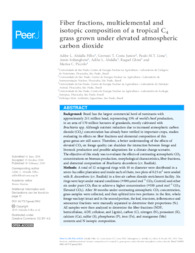Fiber fractions, multielemental and isotopic composition of a tropical C4 grass grown under elevated atmospheric carbon dioxide.
Fiber fractions, multielemental and isotopic composition of a tropical C4 grass grown under elevated atmospheric carbon dioxide.
Author(s): ABDALLA FILHO, A. L.; COSTA JUNIOR, G. T.; LIMA, P. de M. T.; SOLTANGHEISI, A.; ABDALLA, A. L.; GHINI, R.; PICCOLO, M. de C.
Summary: Abstract: Brazil has the largest commercial herd of ruminants with approximately 211 million head, representing 15% of world?s beef production, in an area of 170 million hectares of grasslands, mostly cultivated with Brachiaria spp. Although nutrient reduction due to increased atmospheric carbon dioxide (CO2) concentration has already been verified in important crops, studies evaluating its effects on fiber fractions and elemental composition of this grass genus are still scarce. Therefore, a better understanding of the effects of elevated CO2 on forage quality can elucidate the interaction between forage and livestock production and possible adaptations for a climate change scenario. The objective of this study was to evaluate the effects of contrasting atmospheric CO2 concentrations on biomass production, morphological characteristics, fiber fractions, and elemental composition of Brachiaria decumbens (cv. Basilisk). A total of 12 octagonal rings with 10 m diameter were distributed in a seven-ha coffee plantation and inside each of them, two plots of 0.25 m2 were seeded with B. decumbens (cv. Basilisk) in a free air carbon dioxide enrichment facility. Six rings were kept under natural conditions (?390 ?mol mol?1 CO2; Control) and other six under pure CO2 flux to achieve a higher concentration (?550 ?mol mol?1 CO2; Elevated CO2). After 30 months under contrasting atmospheric CO2 concentration, grass samples were collected, and then splitted into two portions: in the first, whole forage was kept intact and in the second portion, the leaf, true stem, inflorescence and senescence fractions were manually separated to determine their proportions (%). All samples were then analyzed to determine the fiber fractions (NDF, hemicellulose, ADF, cellulose, and Lignin), carbon (C), nitrogen (N), potassium (K), calcium (Ca), sulfur (S), phosphorus (P), iron (Fe), and manganese (Mn) contents and N isotopic composition.
Publication year: 2019
Types of publication: Journal article
Unit: Embrapa Environment
Observation
Some of Embrapa's publications are published as ePub files. To read them, use or download one of the following free software options to your computer or mobile device. Android: Google Play Books; IOS: iBooks; Windows and Linux: Calibre.
Access other publications
Access the Agricultural Research Database (BDPA) to consult Embrapa's full library collection and records.
Visit Embrapa Bookstore to purchase books and other publications sold by Embrapa.

